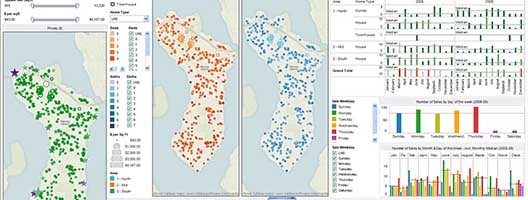Modelling and Simulation

Understanding of Complex Properties Resulting from Multi-source, Multi-parameter
Background
Today’s systems operate within an increasing complex environment with shorter life cycles in an increasing competitive market, thus making the problems engineered systems aim to solve more complex. An integrated approach is needed to look both at the requirements and the solution holistically. To achieve an optimal system design for a given application it is necessary to make critical decisions against a set of inter-dependant system design parameters. Strong and weak dependencies between the many system attributes mean that there may be different solutions as opposed to a single optimised solution. A method for trading system design parameters against each other is needed in order to iterate towards an optimal solution meeting the requirement. System design parameters exist in different dimensions (e.g. cost, functionality, timeframe, actual performance, maintainability, etc.). Additionally, engineering complex systems often involve different domain experts, and system optimisation cannot be achieved by optimising in one domain alone and must consider all domains.
This research project is exploring the possible approaches to handle these challenges by creating an inter-disciplinary multi criteria decision analysis environment for engineering complex systems. This involves creating an overall coupled systems model that allows individual models to interact in the same modelling environment. The modelling framework would allow integration of new and existing models. This would allow experts in one domain to see the consequences or impact of their design decisions on system features outside their own field. The trade analysis is effectively a multi-criteria decision analysis technique that operates between design disciplines.
An important aspect of the research is management of uncertainty and risk – clearly techniques that help to analyse and trade design parameters within that ambiguity will be a significant challenge. Additionally the proposed research will build on the growing field of visual analytics by applying it to systems engineering in order to enable rapid discovery of expected/normal as well as abnormal/unexpected behaviour of complex system designs, thus providing understanding of complex properties and improve the decision making process.
By developing this interactive common modelling environment it will be possible to ‘trade’ design parameters in one domain against parameters in other domains with the aim of allowing optimisation across domains and with the increased understanding of uncertainty and risk correlations it would provide improved insight and confidence in the multidisciplinary trading decisions.
Research Aims
The aim of this research is to improve interdisciplinary design decisions in complex systems by increasing the understanding of system model interactions & inter-relations across domains and provide decision tools to enable better informed design decisions.
Research Objectives
The Problem
What modelling framework enables integration of existing and new models, in order to facilitate interactive exploration of the parameter space to enhance understanding of the overall coupled system model? How can this coupled modelling context be used as an inter-disciplinary Multi Criteria Decision Analysis environment and how can uncertainty be propagated in this framework to improve multidisciplinary design decision confidence when choosing one optimal solution in the optimum solution space.
Sub-Problems
- What modelling framework can integrate existing and new models to enable interactive exploration of the parameter space?
- How can interactive exploration of the parameter space enhance understanding of an overall coupled system model?
- How an inter-disciplinary Multi Criteria Decision Analysis environment can enable the choice of one optimal solution in the optimum solution space?
- How can uncertainty be propagated in a coupled modelling environment?
- How does uncertainty knowledge improve multidisciplinary design decision confidence?
Hypotheses
- A modelling framework establishing the mean & variance relationship between the system outputs (system requirements & key performance metrics) and the models design parameters would enable interactive exploration of the parameter space.
- A visual & interactive analytic approach that combines the computer strengths together with the human natural visual perception ability (High band-width, patterns recognition, etc…) will enhance understanding of an overall coupled system model
- A visual & interactive environment where each discipline exploring the optimised solution space, sees the effect of their design parameters on the overall coupled system will facilitate trade-off and choice of the optimal solution in the optimum solution space.
- A classification (environment, input & output) of uncertainty and appropriate allocation into a Mean & variance modelling framework would propagated uncertainty in a coupled modelling environment.
- A visual & interactive environment where uncertainty is a factor that can be visualised, will provide enhanced knowledge about the different disciplines' uncertainties propagation and effects on the overall coupled system, hence facilitate trade-off and design decision confidence.
